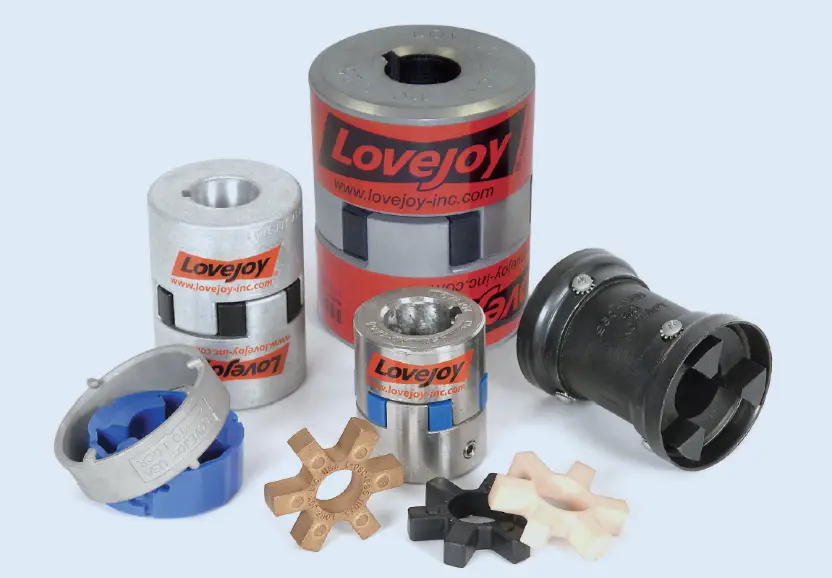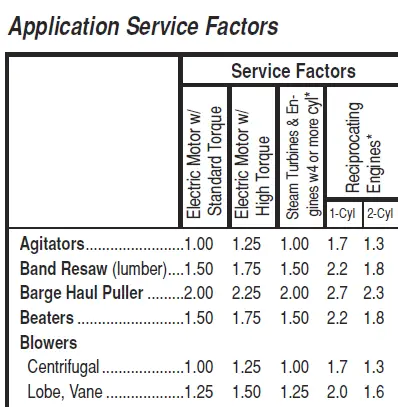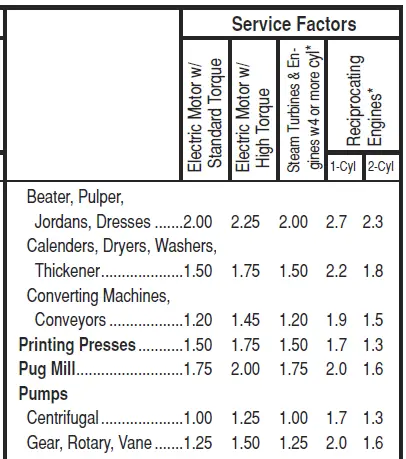
Jaw type shaft couplers are a lifesaver. These wonderful pieces of machinery allow for torque transmission between two different items and account for radial, angular and axial misalignment. It also has built in shock absorption that diffuses impact loads, like from reversing loads, and start up loads. Jaw shaft couplers do this by having a mechanism, the spider, to connect two jaws. One Jaw connects to each shaft and the spider slips between the jaws. Great reasons to use jaw couplers include the following:
- Allow for some misalignment (let’s face it, it is tough to get shafts to align right!)
- Thousands of options for shaft size, torque transmitted and spider material
- No metal to metal contact
- Resistance to dirt and oils
- Nearly maintenance free
- Smaller sizes are readily available (no 8-12 week lead times). You can even buy them on Amazon.
- Fail-safe. If the spider fails, the jaws will still make contact with each other. There will be metal on metal contact there, so be sure to replace the spider when this happens.
Torque and Service factor
The first thing that we must do in selecting the proper jaw type is to calculate the torque and application service factor. Torque is relatively easy and straight forward to calculate. It can be done with the following formulas.
Pretty simple. Now that we have this, we need to look up the service factor from the manufacturers chart. Simply multiply the calculated torque by the service factor to get the torque needed to size the jaw. The service factor is an essential element that accounts for impact loads that will be seen on the coupler. For example, something powered by an electric motor will generally have a lower service factor than one powered by an internal combustion engine. This is because, especially for single cylinder 4 stroke engines, every other rotation contains an impact load when the cylinder fires. Electric motors don’t have that.
Every manufacturer has one of these charts. Look for two or three cases that describe your application. If they have different service factors, always pick the highest factor. I say this because while it may be difficult to justify upfront costs, you will probably never have failures in the joint. Field failures are costly; there is lost production, diagnosing, engineering and fabrication costs, etc. that need to be considered. Generally speaking, when a field failure occurs, there is way too much labor put in to solving the problem which adds up quickly and leads to a lot of cost to the company. It gets worse if you are mass producing this item, because you may now have to add in the costs of field repair or worse, the cost of lost customers. So please, size it to the larger service factor.
Spider Materials
Selecting the right spider material is imperative. It must be able to handle the torque applied and provide adequate shock absorption. It is also important to consider operating temperature. Be sure to keep in mind if the local temperature of the coupler will be higher than the ambient temperature.
A general principle when selecting a spider material is that you are trading shock absorption for torque. A rubber material will definitely offer more shock absorption, than bronze, but bronze will handle much more torque. Let’s take a closer look at the more popular materials:
NBR Rubber
- This common material is used in almost all hydraulic and plumbing seals.
- Inexpensive
- Readily available
- Highly flexible
- Oil resistant
- Great shock absorption
- Good temperature range of -40° to 212° F (-40° to 100° C)
Urethane
- Has 50% more torque capacity than NBR
- Good resistance to oil and chemicals
- Good shock absorption
- Operating temperature range of -30° to 160° F
Hytrel
- Flexible
- High torque
- Greater operating temperature range of -60° to 250° F (-51° to 121° C)
- More expensive
Bronze
- Highest torque rating
- Available in oil-impregnated metal
- Very low speed (keep below 250 rpm)
- Very little shock absorption
- Not affected by water, oil, or dirt
- Highest operating temperature range: -40° to 450° F (-40° to 232° C)
Making application:
In my world, things without a practical application are worthless. So, I wanted to use the log splitter power train as an example.
The power source is a basic Harbor Freight 5 HP gas motor that will meet our needs. Remember a motor should last for years if given proper maintenance and kept covered so that exposure to moisture does not get inside and cause it to rust. These few steps can help you extend the life of a motor and save you money in the long run. On this model, it has a three-quarter inch keyed shaft.
Our pump is a Haldex two stage gear pump with a ½” keyed shaft. Right off the bat, we know we are going to need something to handle the difference in shaft size. A jaw type coupler will be perfect because we can use two different jaw parts.
Ok, let’s get started. I have had great success using Lovejoy L series couplers for applications such as these. We first need to size the jaw part of the coupler and we do this by calculating the torque. We will use the 5 HP engine running at 2500 RPM and come up with 126 in-lb. of torque required.
After finding the nominal torque, the next thing we want to do is make sure we are using the correct service factor. This is an added design factor based on the application. So, looking through the Jaw Application Service Factors guide we do not find a listing for hydraulics. Instead, we will need to find the section where we can locate the proper pump. For this application, we will be using a Rotary Gear Vane Pump and will want to use a higher service factor. In this case, I am going to go ahead and use the 1.50 service factor which will bring our torque to around 190-inch pounds.
Sizing the Coupler
Now let’s look at the actual pieces themselves. First, we will need to size both the spider and the L-series coupler. Looking at the options, I can choose a L095 for NBR, an L090 for Urethane or and L075 for Hytrel or Bronze. Because Hytrel and bronze are the most expensive and least flexible alternatives (not to mention that the speed is too high for bronze), I will not consider them as viable options. The choice is now down to NBR and Urethane. If I choose NBR, I will pay more for the jaws, but less for the spider. The main benefit that I see is the urethane has a higher torque rating (216 in-lb.) at the smaller size than the NBR has at the larger size (194 in-lb.). This will lead to increased life of the spider. In fact, it may never need to be replaced. With all of that said, I will select the L090 with the urethane spider.
Selecting the Spider
Moving on, we will go ahead and select the actual part numbers we need. Remember, we have determined that the coupling size will be the L90 series. Now it is time to find the spider type that fits our application. I prefer to use a type with an open center so that the shafts can go into the space that the spider occupies if needed. Looking at the listing we will need to find the Urethane (open center) spider type and then the intersecting column under the L90 coupling size. Where these two meet we find our part number which in this case is 11075.
Selecting the Jaws
 Now we can find the jaw part number needed for our application. First off, we need to know what shaft size is appropriate. Since our pump has a half inch bore shaft size, we will want to match this up in the part listing. Looking at the chart, we will find where the L090 series column and the 1/2 bore with keyway intersect to locate the part number 26087. Notice that we have a keyway on this which is 1/8 wide and 1/16 tall. Normally the height will be one half of the width for the keyway so that a standard square key can fit. We will do the same for the other shaft which has a 3/4 inch bore size and keyway will 3/16 wide by 3/22 tall. Referencing this size on our chart, we find the L090 column and the part number which will be 10773.
Now we can find the jaw part number needed for our application. First off, we need to know what shaft size is appropriate. Since our pump has a half inch bore shaft size, we will want to match this up in the part listing. Looking at the chart, we will find where the L090 series column and the 1/2 bore with keyway intersect to locate the part number 26087. Notice that we have a keyway on this which is 1/8 wide and 1/16 tall. Normally the height will be one half of the width for the keyway so that a standard square key can fit. We will do the same for the other shaft which has a 3/4 inch bore size and keyway will 3/16 wide by 3/22 tall. Referencing this size on our chart, we find the L090 column and the part number which will be 10773.
After determining and selecting which parts are needed, we will need to go ahead and place an order. I will mention that a great benefit of Lovejoy couplers is the presence of product distributers on Amazon. This makes the ordering process easier and the shipping faster if you have the option to do so.
In addition, I would strongly recommend applying anti-seize to all parts before assembly in order to prevent rusting. This is a huge help if you ever need to take them apart (at some point you will) and it is nearly impossible to do without breaking parts if rust has occurred. For example, I recently had to do this on a project and ended up having to cut a gear in half to remove it from the shaft. Make sure you take this simple step to help prevent the hassle of rusted parts. In the end it will help preserve the parts and aid in the process of disassembling if ever needed.
I hope this information has been helpful in the process of selecting the right parts for your own project. The intent of this article is to familiarize you with jaw couplers, be able to calculate the torque and service factors and finally be able to select the jaw size and spider materials right for your application.
Happy designing!
(All images/charts courtesy of Lovejoy Jaw Type Couplings Catalog)








